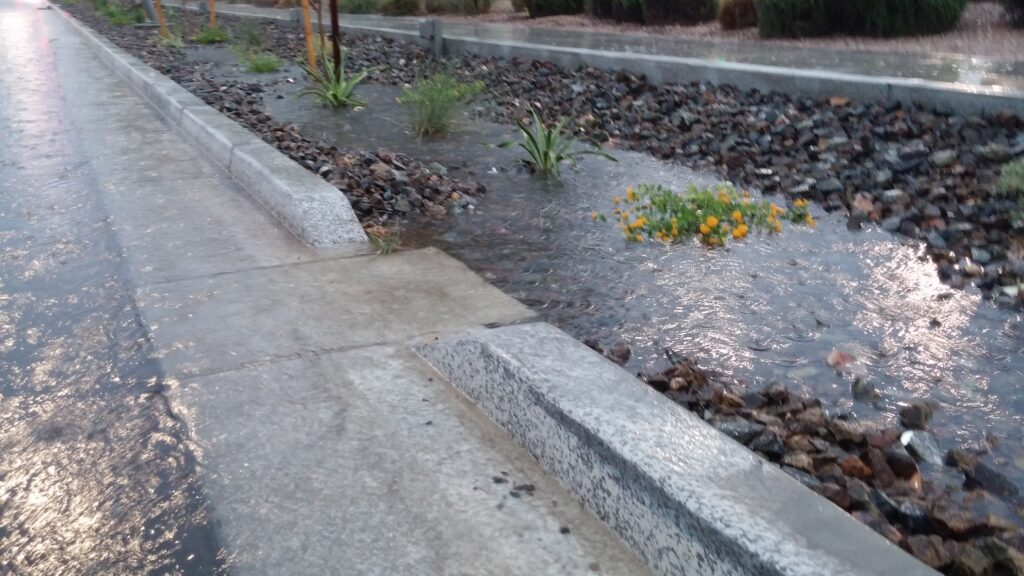Incorporating the Green Infrastructure Handbook
Implementing low impact development design for effective storm management.
Written by: Patrick Wolf, PE | Susanna Mabery

Introduction
Green infrastructure (GI) is an approach to stormwater management that protects, restores, or mimics the natural water cycle as an alternative to discharging directly into storm sewers. A component of stormwater management is low impact development (LID). This type of design uses low-impact solutions to enhance and not significantly diminish environmental quality. LID was first developed by Maryland’s Prince George’s County in 1999, and its benefits were quickly realized for environmental sustainability and water conservation. Using landscaped areas and water collection, stormwater runoff is absorbed, infiltrated, allowed to evaporate, and retained onsite. Keeping the stormwater close to its origination reduces potential pollutants and makes it viable as a source of landscape irrigation. This differs from the methods previously established for stormwater management, which typically involve removing stormwater from a site through means of appropriately designed infrastructure, also known as grey infrastructure.
In the state of Arizona, where the lack of water is a growing concern, municipalities are searching for alternatives for water conservation methods.
LID methods and techniques are growing in popularity as municipalities learn and understand the benefits provided, including:
- Reduces flooding by reducing stormwater peak flows.
- Mitigates heat-island effect by increasing vegetation, such as trees, to provide shade canopies.
- Reduces sediment and pollutant loads reducing water pollution.
- Reduces cost of stormwater infrastructure.
- Improves livability and adds value to the community.
- Prevents degradation of water quality and natural resources.
- Increases marketability/property values.
In urban areas, this design approach is beneficial due to limitations of available land. The need for infrastructure to move water to an offsite location is reduced and land area can be maximized with the LID approach by retaining the stormwater onsite.
LID is also gaining popularity due to its positive impact at a community level. In addition to water conservation, incorporating LID practices includes the use of landscaped vegetation that provide aesthetically pleasing green space.
The Green Infrastructure Handbook is designed to guide municipalities with specific techniques to implement LID design.
The ten technical standard details and specifications (TSDS) developed in that handbook can be used on both public and private projects.

Method
The Maricopa Association of Governments (MAG) is a planning group of local governments working together on developing solutions in areas such as transportation, air quality, and economic development in the Phoenix Metropolitan Area. MAG comprises 27 cities and towns, three Native American communities, Maricopa County, and portions of Pinal County. The MAG Public Works Program standardizes infrastructure construction throughout the region by coordinating the building codes as well as the construction specifications and details used by member agencies. Prior to the GI handbook, there were not any LID specific detailed drawings for agencies to use; therefore, the TSDS were developed to be used in conjunction with the MAG’s Uniform Standard Specifications and Details for Public Works Construction (Standards).
The TSDS developed are to be used for municipalities in the MAG region and are designed to be modified to accommodate project specific needs and conditions such as available area, soil condition, and/or cost. Geotechnical and engineering studies should be conducted for sufficient design of GI. The soil and percolation rates need to be evaluated to determine appropriate LID elements that can be implemented. Other factors to consider during the design phase include the location of underground utilities, subsurface infiltration rates, size and storage capacity of a detention facility, the location of LID features relative to buildings, property lines, water supply wells, and septic systems.
The 10 TSDS are as follows:
- Permeable Pavements
- Curb Openings – Option 1 & 2
- Curb Openings – Option 3 & 4
- Sediment Traps
- Stormwater Harvesting Basins
- Vegetated or Rock Bioswales
- Bioretention Systems
- Curb Extensions
- Bioretention Planters
- Domed Overflow Structures
Maintenance of each LID standard is important to the success and performance of the feature. The development of each detail considered the processes and procedures to properly maintain the feature to ensure efficiency. Each detail includes maintenance guidelines, with inspection and possible cleanout, occurring typically after a storm event of 0.5 inches or greater. The carefully designed details will ease maintenance efforts, keeping costs down, and increasing the effectiveness of the design.

Bioretention Planter 
Curb Opening 
Rock Bioswale
Landscaping is an imperative aspect for LID elements to properly function and for aesthetic value. Stormwater flow is reduced with landscaped features, increasing the water retention and absorption. Plants selected for landscaping are drought tolerant and will survive the high temperatures of the Phoenix area. Planting guidelines for spacing and proximity to LID drainage features, as well as landscape maintenance, is outlined in the handbook. LID techniques must also account for the soil types of this region to ensure proper drainage is achieved and for plant survivability. Each project should evaluate the soil conditions to determine whether LID is sustainable for that site.
Plan of Action
Arizona State University’s (ASU’s) Sustainable Cities Network (SCN) is an active leader in promoting sustainable solutions for the future of the Phoenix area and are a strong proponent of the use of GI. SCN interacts with Arizona cities, towns, tribal communities, counties, government agencies, and other public and private entities to educate and communicate how to use GI for local and regional sustainability. The development of this handbook was orchestrated through SCN with the help of SCN’s Specifications and Standards Subgroup, which includes the cities of Scottsdale and Phoenix, as well as the Flood Control District of Maricopa County (FCDMC).
The City of Scottsdale was integral in the development of the handbook by acquiring grant funding from the Arizona Department of Environmental Quality and from the Water Infrastructure Finance Authority. Significant stakeholders also involved in the creation of the handbook included the cities of Phoenix, Apache Junction, Glendale, Goodyear, Mesa, and Tempe, as well as the FCDMC and ASU’s SCN. These stakeholders provided initial screening and evaluation of alternative options. The stakeholders ranked the alternatives and chose the top 10 TSDS.
Dibble and Logan Simpson Design teamed together to develop the GI handbook’s design details, the landscape selection, and requirements.
The TSDS required engineering knowledge of the current MAG standards and specific details of the infrastructure performance in terms of applicability, constructability, design considerations, maintenance, compatibility, and dimensional aspects.
Conclusion
The LID TSDS defined in the handbook can be incorporated into future city and county development projects, as a sustainable solution and without any additional design costs. It is anticipated that these details will be incorporated into the MAG standard details and specifications.
Markets Mentioned
Water+Wastewater
Services Mentioned
Flood Control
This Case Study PDF
Project Details
Project
Green Infrastructure Handbook
Location
Various
Market
Flood Control
Owner
City of Scottsdale
Engineer
Dibble
Environmental/Landscape Architect
Logan Simpson
Delivery Method
Study

